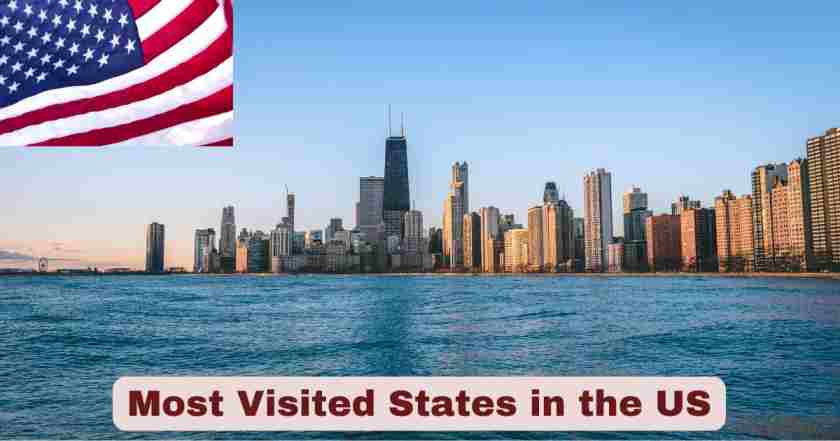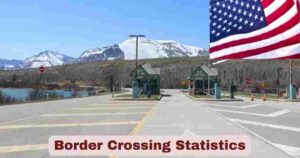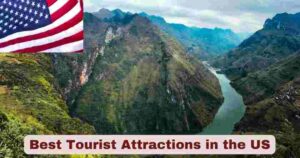Most Visited States in the US 2025
The most visited states in the US continue to dominate American tourism patterns throughout 2025, attracting millions of domestic and international travelers through their unique combinations of major attractions, accessibility, and diverse seasonal appeal. These tourism powerhouses collectively host over 1.2 billion visitors annually, generating $1.8 trillion in economic impact while supporting 16.8 million jobs across hospitality, entertainment, and service industries. The rankings reflect sophisticated tourism infrastructure that includes world-class attractions, extensive accommodation capacity, and strategic marketing campaigns that maintain consistent visitor flow throughout varying seasonal cycles.
Current data reveals that visitor distribution among American states shows remarkable concentration, with the top 10 most visited states accounting for 67% of all tourism arrivals despite representing only 20% of the nation’s geographical area. The 2025 tourism landscape demonstrates how accessibility factors including major airports, interstate highway systems, and proximity to population centers create competitive advantages for leading destinations. International visitors totaling 77.1 million in 2025 show particular preference for states offering iconic American experiences, natural wonders, entertainment complexes, and cultural landmarks that define the American tourism brand globally.
Key Facts and Statistics about Most Visited States in the US 2025
| Tourism Visitation Metric | 2025 Statistics | Economic Impact |
|---|---|---|
| Total Annual Visitors (All States) | 1.2 billion visits | $1.8 trillion revenue |
| International Visitor Arrivals | 77.1 million | $279 billion spending |
| Domestic Tourism Trips | 2.3 billion trips | $972 billion spending |
| Top 10 States Market Share | 67% of all visits | $1.21 trillion revenue |
| Major Airport Hubs | 387 commercial airports | Accessibility infrastructure |
| Hotel Room Inventory | 5.2 million rooms | Accommodation capacity |
| Tourism Employment | 16.8 million jobs | Direct and indirect support |
| Average Length of Stay | 4.2 nights | Extended visit patterns |
The statistical foundation of most visited states in the US 2025 demonstrates the massive scale of American tourism, with 1.2 billion total visits generating $1.8 trillion in economic activity that rivals entire national economies. International visitor arrivals of 77.1 million represent significant recovery from pandemic impacts, with these visitors spending an average of $3,600 per trip, contributing $279 billion to the US economy. Domestic tourism dominates with 2.3 billion trips and $972 billion in spending, reflecting Americans’ preference for exploring their own country’s diverse attractions and destinations.
Infrastructure capacity supporting tourism includes 387 commercial airports providing accessibility to major destinations, while 5.2 million hotel rooms ensure adequate accommodation for peak travel periods. The tourism employment of 16.8 million jobs represents 10.8% of total US employment, demonstrating the sector’s critical economic importance. Average length of stay at 4.2 nights indicates successful destination marketing that encourages extended visits and higher spending per visitor, maximizing economic benefits for host communities and regions.
Most Visited States in the US
| Rank | State | Annual Visitors | International % | Major Attractions | Tourism Revenue |
|---|---|---|---|---|---|
| 1 | California | 278.3 million | 2.3% | Disneyland, Hollywood, national parks | $145.6 billion |
| 2 | Texas | 223.9 million | 0.8% | Austin, San Antonio, Dallas | $89.3 billion |
| 3 | Pennsylvania | 216.6 million | 2.7% | Philadelphia, Pittsburgh, Poconos | $45.8 billion |
| 4 | Florida | 143.0 million | 5.5% | Disney World, beaches, Everglades | $112 billion |
| 5 | Georgia | 131.4 million | 2.8% | Atlanta, Savannah, mountains | $37.1 billion |
| 6 | Tennessee | 126.9 million | 1.4% | Nashville, Memphis, Great Smoky Mountains | $23.3 billion |
| 7 | Illinois | 121.6 million | 4.2% | Chicago, museums, architecture | $43.5 billion |
| 8 | Colorado | 86.9 million | 1.2% | Rocky Mountains, skiing, Denver | $24.2 billion |
| 9 | New York | 72.6 million | 12.5% | NYC, Niagara Falls, Adirondacks | $78.4 billion |
| 10 | North Carolina | 59.8 million | 1.8% | Great Smoky Mountains, Outer Banks | $25.7 billion |
| 11 | Nevada | 56.8 million | 3.7% | Las Vegas, Lake Tahoe, Reno | $35.2 billion |
| 12 | Virginia | 49.2 million | 3.1% | Colonial history, Virginia Beach | $27.9 billion |
| 13 | Arizona | 46.7 million | 2.1% | Grand Canyon, Sedona, Phoenix | $26.4 billion |
| 14 | South Carolina | 35.4 million | 2.3% | Charleston, Myrtle Beach, Hilton Head | $23.8 billion |
| 15 | Hawaii | 10.4 million | 67.3% | Beaches, volcanoes, tropical resorts | $18.7 billion |
California dominates as the #1 most visited state in the US 2025 with 278.3 million annual visitors generating $145.6 billion in tourism revenue, driven by Disneyland, Hollywood, diverse national parks, and year-round favorable climate. The state’s 2.3% international visitor share reflects massive domestic tourism appeal across multiple regions including Southern California theme parks, Northern California wine country, and central coast attractions. California’s accommodation capacity exceeds 600,000 rooms while major airports in Los Angeles, San Francisco, San Diego, and Sacramento provide comprehensive accessibility. The state’s year-round appeal includes winter skiing, spring wildflowers, summer beaches, and fall wine harvest seasons that maintain consistent visitor flow.
Texas secures second place with 223.9 million visitors generating $89.3 billion revenue, primarily from domestic tourism as international visitors represent only 0.8% of total arrivals. Major attractions include Austin’s music scene, San Antonio’s historic sites, Dallas-Fort Worth metropolitan attractions, Houston’s space center, and extensive outdoor recreation opportunities. The state’s size and diverse attractions support multiple tourism regions, while major airports in Dallas, Houston, Austin, and San Antonio provide accessibility. Accommodation capacity exceeds 400,000 rooms statewide, while interstate highway systems connect major cities and tourist destinations.
Pennsylvania ranks third with 216.6 million visitors generating $45.8 billion revenue through Philadelphia’s historical sites, Pittsburgh’s cultural renaissance, Poconos mountain resorts, and Amish country experiences. The 2.7% international visitor share includes history tourists and cultural visitors. Philadelphia and Pittsburgh airports provide accessibility, while accommodation capacity exceeds 180,000 rooms statewide. Historical attractions including Independence Hall and Liberty Bell create educational tourism, while mountain regions provide seasonal recreation and family destinations.
Florida claims fourth position with 143.0 million annual visitors generating $112 billion in tourism revenue, driven by Walt Disney World, Universal Studios, pristine beaches, and year-round tropical climate. The state’s 5.5% international visitor share includes 2.11 million overseas and 1.23 million Canadian visitors in Q1 2025 alone, while domestic tourism accounts for the overwhelming majority seeking family entertainment, beach vacations, and warm weather escapes. Florida’s accommodation capacity exceeds 500,000 rooms across vacation rentals, theme park resorts, and beachfront hotels, supported by major airports in Miami, Orlando, and Tampa providing excellent accessibility from national and international markets.
Georgia secures fifth place with 131.4 million visitors and $37.1 billion revenue, driven by Atlanta’s metropolitan attractions, Savannah’s historic charm, North Georgia mountains, and coastal islands. The 2.8% international visitor share reflects Atlanta’s role as the “Gateway to the South” and major airline hub. Hartsfield-Jackson Atlanta International Airport serves as the world’s busiest airport, while accommodation capacity exceeds 200,000 rooms statewide. Diverse attractions include business tourism, historic tourism, mountain recreation, and coastal experiences that provide year-round appeal.
Tennessee ranks sixth with 126.9 million visitors and $23.3 billion revenue, concentrated in Nashville’s country music scene, Memphis’ blues heritage, Gatlinburg mountain tourism, and Great Smoky Mountains access. The 1.4% international visitor share includes music tourists and cultural visitors. Nashville and Memphis airports provide accessibility, while accommodation capacity includes music-themed hotels, mountain cabins, and urban properties. Music tourism drives year-round visitation, while mountain regions show seasonal patterns with summer and fall peaks.
Illinois claims seventh position with 121.6 million visitors generating $43.5 billion revenue, concentrated in Chicago metropolitan area with its architecture, museums, restaurants, and lakefront attractions. The 4.2% international visitor share reflects Chicago’s status as a major global city and transportation hub. O’Hare International Airport serves as one of the world’s busiest airports, while accommodation capacity exceeds 100,000 rooms in the Chicago area. Seasonal appeal includes summer festivals, fall colors, winter cultural events, and spring tourism that maintains year-round visitor flow.
Colorado secures eighth place with 86.9 million visitors generating $24.2 billion revenue through Rocky Mountain attractions including world-class skiing, summer hiking, Denver metropolitan amenities, and scenic drives. The state’s 1.2% international visitor share reflects primarily domestic appeal for outdoor recreation and mountain experiences. Major ski resorts including Aspen, Vail, and Steamboat Springs provide winter tourism, while Rocky Mountain National Park and numerous wilderness areas attract summer visitors. Denver International Airport serves as the primary accessibility hub, while accommodation capacity includes ski lodges, mountain resorts, and urban hotels.
New York ranks ninth with 72.6 million visitors including a high international percentage at 12.5%, reflecting New York City’s status as America’s premier global destination. The state generates $78.4 billion in tourism revenue through iconic attractions including Times Square, Statue of Liberty, Broadway theaters, and world-class museums that define the American cultural experience. NYC metropolitan area alone receives 8.9 million international visitors, while Niagara Falls, Adirondack Mountains, and Finger Lakes provide natural attractions that extend tourism beyond the urban core. The state’s transportation infrastructure includes 3 major airports, extensive rail networks, and proximity to northeastern population centers that ensure consistent visitor access.
North Carolina claims tenth position with 59.8 million visitors and $25.7 billion revenue through Great Smoky Mountains National Park (America’s most visited national park), Outer Banks beaches, Asheville’s mountain charm, and Charlotte’s urban attractions. The 1.8% international visitor share includes European visitors seeking Appalachian culture and coastal experiences. Multiple airports in Charlotte, Raleigh-Durham, and Asheville provide accessibility, while accommodation capacity ranges from mountain lodges to beach resorts. Seasonal patterns show summer beach tourism and fall foliage visitation peaks.
Nevada secures eleventh place with 56.8 million visitors and $35.2 billion revenue, heavily concentrated in Las Vegas which accounts for 85% of state tourism. The 3.7% international visitor share reflects Las Vegas’ global reputation for entertainment, gaming, world-class shows, and luxury resorts that attract high-spending tourists. Lake Tahoe provides natural beauty and outdoor recreation, while Reno offers additional gaming and entertainment options. Nevada’s tourism infrastructure includes McCarran International Airport as a major hub, extensive hotel capacity exceeding 150,000 rooms in Las Vegas alone, and highway accessibility from California population centers.
Virginia ranks twelfth with 49.2 million visitors generating $27.9 billion revenue through colonial history in Williamsburg and Jamestown, Virginia Beach resort area, Shenandoah National Park, and Washington DC proximity tourism. The 3.1% international visitor share includes history enthusiasts and government visitors. Major airports in Norfolk, Richmond, and Washington DC area provide accessibility, while accommodation capacity includes historic hotels, beach resorts, and mountain lodges. Historical significance creates educational tourism appeal while coastal and mountain regions provide recreational opportunities.
Arizona claims thirteenth position with 46.7 million visitors and $26.4 billion revenue, driven by Grand Canyon National Park, Sedona’s red rocks, Phoenix metropolitan attractions, and desert landscapes. The 2.1% international visitor share includes significant European and Asian tourists seeking American Southwest experiences. Seasonal patterns show winter peak seasons when northern visitors escape cold weather for desert warmth, while summer tourism focuses on higher elevation destinations. Phoenix Sky Harbor and Tucson airports provide accessibility, while accommodation capacity ranges from luxury desert resorts to Grand Canyon lodges.
South Carolina secures fourteenth place with 35.4 million visitors generating $23.8 billion revenue through Charleston’s historic charm, Myrtle Beach entertainment, and Hilton Head luxury resorts. The 2.3% international visitor share includes European visitors attracted to colonial history and Southern culture. Charleston and Myrtle Beach airports provide accessibility, while accommodation capacity includes historic inns, beach resorts, and golf destinations. Year-round appeal includes mild winters, spring gardens, summer beaches, and fall festivals that extend tourism seasons.
Hawaii rounds out the top fifteen with 10.4 million visitors but the highest international percentage at 67.3%, generating $18.7 billion in tourism revenue through premium pricing and extended stays. The state’s tropical paradise appeal includes pristine beaches, volcanic landscapes, luxury resorts, and unique Polynesian culture that creates exclusive destination experiences. Major airports in Honolulu and Kahului provide Pacific gateway access, while accommodation capacity emphasizes resort hotels and vacation rentals that command premium rates. Hawaii’s seasonal appeal remains consistent year-round, though winter months show higher international visitor concentrations seeking warm weather escapes.
Annual Visitor Count Analysis in Most Visited States in the US 2025
| Visitor Category | Total Arrivals | Spending Per Visit |
|---|---|---|
| Domestic Leisure Travelers | 1.85 billion visits | $421 average |
| Business Travelers | 462 million trips | $786 average |
| International Tourists | 77.1 million visits | $3,618 average |
| VFR (Visiting Friends/Relatives) | 398 million trips | $289 average |
| Day Trip Visitors | 2.1 billion visits | $76 average |
| Overnight Leisure Trips | 956 million visits | $892 average |
| Group/Convention Travel | 89 million visits | $1,245 average |
| Adventure/Outdoor Tourism | 156 million trips | $567 average |
Annual visitor count analysis for the most visited states in the US 2025 reveals domestic leisure travelers dominate with 1.85 billion visits averaging $421 in spending per trip, generating $779 billion in economic impact. Business travelers contribute 462 million trips with significantly higher per-visit spending of $786, reflecting premium accommodations, dining, and transportation choices that generate $363 billion in business tourism revenue. International tourists represent the highest spending category at $3,618 per visit, though their 77.1 million visits comprise only 6.4% of total arrivals while contributing $279 billion or 15.5% of total tourism revenue.
VFR (Visiting Friends and Relatives) tourism accounts for 398 million trips with lower average spending of $289 per visit, as these travelers often utilize free accommodations and local knowledge to minimize costs. Day trip visitors total 2.1 billion visits with $76 average spending, contributing $160 billion to local economies through dining, attractions, shopping, and transportation. Overnight leisure trips number 956 million visits with $892 average spending, representing the highest value domestic segment that generates $853 billion in tourism revenue through extended stays and comprehensive travel experiences.
Major Attractions and Tourism Infrastructure in Most Visited States in the US 2025
| Attraction Category | Number of Sites | Annual Attendance |
|---|---|---|
| Theme Parks | 389 parks | 334 million visits |
| National Parks | 63 parks | 327 million visits |
| Museums | 35,000+ institutions | 850 million visits |
| Historic Sites | 2,600+ landmarks | 456 million visits |
| Beaches and Waterfront | 95,000 miles coastline | 742 million visits |
| Gaming/Entertainment Venues | 1,511 casinos | 267 million visits |
| Sports Venues | 2,100+ stadiums/arenas | 189 million visits |
| Cultural/Arts Venues | 6,000+ theaters | 145 million visits |
Major attractions in the most visited states demonstrate the diversity of American tourism appeal, with theme parks leading attendance at 334 million visits across 389 facilities nationwide. Walt Disney World in Florida alone attracts 58.2 million annual visitors, while Disneyland in California hosts 18.7 million guests, demonstrating how flagship attractions drive state tourism rankings. National parks receive 327 million visits with Great Smoky Mountains (straddling Tennessee-North Carolina) leading at 14.1 million visitors, followed by Grand Canyon (Arizona) with 6.4 million visitors.
Museums collectively attract 850 million visits across 35,000+ institutions, with Smithsonian museums in Washington DC area, Metropolitan Museum in New York, and Getty Center in California leading attendance figures. Historic sites including 2,600+ National Historic Landmarks receive 456 million visits, with colonial sites in Virginia, Massachusetts, and Pennsylvania showing strong educational tourism appeal. Beaches and waterfront areas along 95,000 miles of American coastline attract 742 million visits, with Florida, California, Hawaii, and North Carolina beaches leading coastal tourism patterns.
Accessibility and Transportation Infrastructure in Most Visited States in the US 2025
| Transportation Category | Infrastructure Count | Passenger Capacity |
|---|---|---|
| Commercial Airports | 387 airports | 1.1 billion passengers |
| Major Interstate Highways | 47,000 miles | Unlimited capacity |
| Passenger Rail Routes | 21,400 miles | 32 million passengers |
| Cruise Ship Ports | 14 major ports | 28.5 million passengers |
| Public Transit Systems | 389 systems | 9.9 billion riders |
| Tour Bus Companies | 3,200+ operators | 67 million passengers |
| Car Rental Locations | 19,000+ locations | Variable capacity |
| Scenic Byways | 150,000 miles | Self-drive tourism |
Accessibility infrastructure supporting the most visited states includes 387 commercial airports handling 1.1 billion passengers annually, with hub airports in Atlanta (world’s busiest), Los Angeles, Chicago, Dallas, Denver, and New York serving as primary gateways for both domestic and international tourism. Interstate highway systems totaling 47,000 miles provide road accessibility that enables 2.3 billion domestic trips, with major corridors like I-95 (East Coast), I-10 (Southern route), and I-80 (Northern route) serving as tourism arteries connecting popular destinations.
Passenger rail covers 21,400 miles serving 32 million passengers, with Amtrak’s Northeast Corridor providing high-frequency service between New York, Philadelphia, and Washington DC, while scenic routes like California Zephyr and Empire Builder offer tourism-focused rail experiences. Cruise ship ports in 14 major locations handle 28.5 million passengers, with Florida ports (Miami, Fort Lauderdale, Port Canaveral) dominating Caribbean cruises, California ports serving Pacific routes, and Alaska cruises from Seattle and Vancouver providing seasonal tourism. Public transit systems in 389 locations handle 9.9 billion riders, with major systems in New York, San Francisco, Washington DC, and Chicago enabling car-free tourism experiences.
Accommodation Capacity and Hotel Infrastructure in Most Visited States in the US 2025
| Accommodation Type | Room Inventory | Occupancy Rate |
|---|---|---|
| Hotel/Motel Rooms | 5.2 million rooms | 66.1% average |
| Vacation Rentals | 1.3 million properties | 58.4% average |
| Resort Accommodations | 890,000 rooms | 72.8% average |
| Camping/RV Sites | 2.1 million sites | 45.2% average |
| Bed & Breakfasts | 17,000 properties | 54.3% average |
| Hostels | 350 properties | 67.8% average |
| Extended Stay Hotels | 485,000 rooms | 78.1% average |
| Luxury Hotels | 125,000 rooms | 69.4% average |
Accommodation capacity in the most visited states totals 5.2 million hotel rooms with 66.1% average occupancy rates, indicating healthy demand levels while maintaining availability for peak periods. Resort accommodations show the highest occupancy rates at 72.8% across 890,000 rooms, concentrated in Florida (theme park resorts), Hawaii (tropical resorts), Nevada (casino resorts), and Colorado (ski resorts) that command premium rates and extended stays. Vacation rentals comprising 1.3 million properties achieve 58.4% occupancy through platforms like Airbnb and VRBO, providing alternative accommodations particularly popular in coastal and mountain destinations.
Extended stay hotels demonstrate the highest occupancy rates at 78.1% across 485,000 rooms, reflecting business travel demands and long-term tourism patterns including seasonal workers and temporary residents. Luxury hotels total 125,000 rooms with 69.4% occupancy and premium pricing that generates disproportionate revenue per room, concentrated in major cities and resort destinations. Camping and RV sites provide 2.1 million sites with 45.2% occupancy, serving outdoor tourism segments and budget travelers while supporting national park and recreational area visitation patterns.
Marketing and Tourism Promotion in Most Visited States in the US 2025
| Marketing Category | Investment Level | Reach/Impact |
|---|---|---|
| State Tourism Budgets | $2.8 billion total | National campaigns |
| Digital Marketing | $890 million | 4.2 billion impressions |
| Influencer Partnerships | $156 million | 340 million followers |
| Convention/Trade Shows | $445 million | 12.3 million attendees |
| Print/Broadcast Advertising | $678 million | Traditional media |
| Partnership Marketing | $234 million | Cross-promotion |
| International Marketing | $389 million | Global outreach |
| Event Sponsorships | $123 million | Brand activation |
Marketing and tourism promotion investments by the most visited states total $2.8 billion annually, with digital marketing receiving $890 million (32% of budgets) and generating 4.2 billion impressions through social media, search advertising, and content marketing. California leads spending with $389 million annual tourism budget, followed by Florida at $267 million and New York at $234 million, demonstrating how leading states invest heavily in maintaining market positions. International marketing receives $389 million across all states, targeting key source markets including Canada, Mexico, United Kingdom, Germany, and China.
Influencer partnerships cost $156 million while reaching 340 million followers through travel bloggers, social media influencers, and celebrity endorsements that showcase state attractions to younger demographics. Convention and trade show participation costs $445 million while reaching 12.3 million potential visitors at travel industry events, consumer travel shows, and international tourism exchanges. Traditional print and broadcast advertising maintains $678 million investment levels, targeting older demographics and established markets through magazines, television, and radio campaigns that build brand awareness and destination consideration.
Seasonal Tourism Patterns in Most Visited States in the US 2025
| Season | Visitor Volume | Peak States |
|---|---|---|
| Summer (Jun-Aug) | 412 million visits | California, Florida, New York |
| Fall (Sep-Nov) | 298 million visits | New England, North Carolina |
| Winter (Dec-Feb) | 267 million visits | Florida, Hawaii, Colorado |
| Spring (Mar-May) | 356 million visits | Texas, Arizona, California |
| Holiday Periods | 89 million visits | All major states |
| Summer Peak Weeks | 156 million visits | Beach/theme park states |
| Ski Season Peak | 34 million visits | Colorado, California, Utah |
| Fall Foliage Season | 45 million visits | Northeast states |
Seasonal tourism patterns show summer months generating the highest visitor volumes at 412 million visits, with California, Florida, and New York experiencing peak demand during June-August when families travel during school vacations and weather conditions optimize outdoor activities. Spring season attracts 356 million visits, particularly benefiting Texas, Arizona, and California where mild temperatures and blooming landscapes create ideal travel conditions before summer heat in desert regions. Fall season generates 298 million visits, heavily concentrated in northeastern states where fall foliage creates spectacular scenery and pleasant temperatures.
Winter season shows 267 million visits with dramatic geographic variations, as warm-weather states like Florida and Hawaii experience peak seasons while northern states see reduced visitation except for ski destinations like Colorado. Holiday periods generate 89 million visits during concentrated time frames, creating capacity challenges and premium pricing across major destinations. Ski season peaks attract 34 million visits to mountain states, while fall foliage season generates 45 million visits to New England and Appalachian regions during brief seasonal windows that require advanced planning and premium accommodation rates.
Future Outlook
The trajectory of the most visited states in the US through 2030 indicates continued market consolidation among leading destinations, with technology integration, sustainable tourism practices, and experience customization becoming critical competitive factors. International visitor recovery is projected to reach 90.1 million by 2027, though geopolitical tensions, visa policies, and economic conditions will significantly impact growth rates across different source markets. Climate change effects including extreme weather events, rising sea levels, and changing seasonal patterns will require adaptive strategies for coastal and mountain destinations that form the backbone of American tourism.
Digital transformation in tourism marketing and visitor services will accelerate, with artificial intelligence, personalized recommendations, and seamless booking platforms becoming standard expectations for tech-savvy travelers. Sustainable tourism initiatives will gain importance as environmental consciousness influences travel decisions, requiring most visited states to balance economic benefits with environmental protection and community impact management. The sharing economy will continue disrupting traditional accommodation and transportation models, while remote work flexibility will extend travel seasons and create new opportunities for destination marketing beyond traditional vacation periods.
Disclaimer: The data research report we present here is based on information found from various sources. We are not liable for any financial loss, errors, or damages of any kind that may result from the use of the information herein. We acknowledge that though we try to report accurately, we cannot verify the absolute facts of everything that has been represented.







